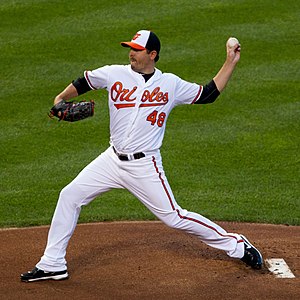 In 2012, Saunders pitched for both the Arizona Diamondbacks and the Baltimore Orioles going 9-13 with a 4.07 ERA. Saunders features a three pitch mix: fastball, curveball, and change up. His fastball averaged 88.9 mph in 2012. Despite the velocity of his fastball decreasing by a couple miles per hour over the last few seasons, according to Fangraphs the pitch was actually the most valuable it has been since 2009. Perhaps, the slightly diminished velocity has enabled Saunders to get more life on the ball, who knows? For some reason, I am not overly concerned.
In 2012, Saunders pitched for both the Arizona Diamondbacks and the Baltimore Orioles going 9-13 with a 4.07 ERA. Saunders features a three pitch mix: fastball, curveball, and change up. His fastball averaged 88.9 mph in 2012. Despite the velocity of his fastball decreasing by a couple miles per hour over the last few seasons, according to Fangraphs the pitch was actually the most valuable it has been since 2009. Perhaps, the slightly diminished velocity has enabled Saunders to get more life on the ball, who knows? For some reason, I am not overly concerned.What would also typically be a concern is Saunders' fly ball percentage, which typically has been among the highest in Major League Baseball. In 2012, Saunders' fly ball percentage stood at 35.6%. This mark is very consistent with Saunders' career tendencies (35.8%).
After the resurgence of Jeremy Guthrie and the former turnaround from Bruce Chen, both of which are fly ball pitchers in their own right, I can't help but wonder if Kauffman Stadium is an ideal fit for this type of pitcher. As we all know, Kauffman Stadium has deep power alleys and has historically suppressed home run totals.
Based on the park factors discussed in this post, last season Kauffman was very average in the home run department. It ranked 16th in all of baseball allowing just 2.8% more than the league average. However, according to ParkFactors.com, between 2008-2011 Kauffman Stadium kept home run totals at 20% below the league average. In case the team record of 36 home runs wasn't enough, this information also supports the theory that the 'K' keeps home run totals down.
This lends credence to the thought that fly ball pitchers could thrive in Kansas City. To try and keep things simple just consider this. Fly balls are converted into outs at a higher rate than ground balls. It is partly for this reason that player's holding higher ground ball percentages often have higher batting average on balls in play than their line drive percentages would seem to predict.
The reason that team's typically prefer ground ball pitchers is because, while ground balls may reach the outfield for more hits, they generally don't wind up in the seats. I am theorizing that if in fact Kauffman Stadium does do such a good job of keep fly balls in the yard, fly ball pitchers should fair better in Kansas City than most other stadiums.
I know this is nothing incredibly ground breaking, but I do believe this line of thinking has been largely overlooked by many including the Royals front office. This is a bit of a continuation from a previous post, but maybe this is one way in which the Kansas City Royals could play to their park and achieve a stronger home field advantage.
As far as Joe Saunders goes, not only should we note that he is a fly ball pitcher, but we should also note where he has been a fly ball pitcher. In 2012, Joe Saunders threw 130 innings with the Arizona Diamondbacks, while calling Chase Field his home. Of course, Chase Field ranks sixth in home runs PF allowing 19.2 percent more than a truly neutral park. At midseason, Saunders was traded to the Baltimore Orioles, whose home park ranked fifth in home run PF, allowing 31.4% above neutrality.
 Despite the recipe for disaster in coupling a fly ball pitcher with home run friendly parks, Saunders poured in arguably the best season of his career posting a lower xFIP (4.25) than he had in his first seven big league seasons. He was able to accomplish this by upping his K/9 to 5.77, while finishing with the lowest BB/9 of his career at 2.01.
Despite the recipe for disaster in coupling a fly ball pitcher with home run friendly parks, Saunders poured in arguably the best season of his career posting a lower xFIP (4.25) than he had in his first seven big league seasons. He was able to accomplish this by upping his K/9 to 5.77, while finishing with the lowest BB/9 of his career at 2.01.If Saunders is in fact a free agent, as MLB Trade Rumors indicates (Baseball Reference says he has one more year of arbitration), Joe Saunders could be an interesting target for the Kansas City Royals. If he isn't a free agent, perhaps he could come for cheap via trade. Saunders made $6 million in 2012, and will likely garner a similar salary in 2013. He isn't a flashy guy, but he could very well be a terrific fit in Kauttman Stadium.
I give my endorsement if the Royals can grab him on a one year contract for around $6 million or a two year deal for around $10 million. At Kauffman I would envision Saunders logging around 200 innings with an ERA just below 4. How many pitchers in the last ten years have the Royals had that we can say that of?

No comments:
Post a Comment